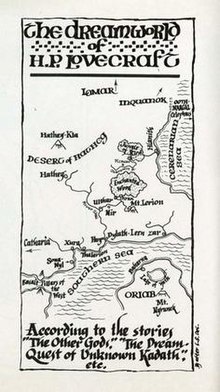Dream Cycle: Difference between revisions
204.111.92.114 (talk) Tags: Mobile edit Mobile web edit |
204.111.92.114 (talk) Tags: Mobile edit Mobile web edit |
||
| Line 6: | Line 6: | ||
The Dreamlands are apparently divided into four regions: |
The Dreamlands are apparently divided into four regions: |
||
* The '''West''' contains the ''Steps of Deeper Slumber '' (descended via the "Cavern of Flame") and [[The Enchanted |
* The '''West''' contains the ''Steps of Deeper Slumber '' (descended via the "Cavern of Flame") and [[The Enchanted Wood (H.P. Lovecraft)|Enchanted Wood]] by which many enter the Dreamlands. Other points of interest include the port of [[Dylath-Leen]], one of the Dreamlands' largest cities; the town of [[Ulthar]] "where no man may kill a cat,"<ref>[http://www.hplovecraft.com/writings/texts/fiction/cu.asp "The Cats of Ulthar" by H. P. Lovecraft<!-- Bot generated title -->]</ref> the coastal jungle city of Hlanith, and the desert trading capital Illarnek. Here, too, lies the land of Mnar whose gray stones are etched with signs and where rise the ruins of the great [[The Doom that Came to Sarnath|Sarnath]]. |
||
* The ''' South,''' home of the isle of [[Oriab]] and the areas known as the Fantastic Realms (described in "The White Ship"). |
* The ''' South,''' home of the isle of [[Oriab]] and the areas known as the Fantastic Realms (described in "The White Ship"). |
||
* The '''East,''' home of [[Celephaïs]], a city dreamt into being by its monarch [[Kuranes]], greatest of all recorded dreamers, and the dangerous Forbidden Lands. |
* The '''East,''' home of [[Celephaïs]], a city dreamt into being by its monarch [[Kuranes]], greatest of all recorded dreamers, and the dangerous Forbidden Lands. |
||
Revision as of 21:51, 23 December 2015
The Dream Cycle is a series of short stories and novellas by author H. P. Lovecraft[1] (1890–1937). Written between 1918 and 1932, they concern themselves with "The Dreamlands," a vast, alternate dimension that can be entered via dreams.

Geography
The Dreamlands are apparently divided into four regions:
- The West contains the Steps of Deeper Slumber (descended via the "Cavern of Flame") and Enchanted Wood by which many enter the Dreamlands. Other points of interest include the port of Dylath-Leen, one of the Dreamlands' largest cities; the town of Ulthar "where no man may kill a cat,"[2] the coastal jungle city of Hlanith, and the desert trading capital Illarnek. Here, too, lies the land of Mnar whose gray stones are etched with signs and where rise the ruins of the great Sarnath.
- The South, home of the isle of Oriab and the areas known as the Fantastic Realms (described in "The White Ship").
- The East, home of Celephaïs, a city dreamt into being by its monarch Kuranes, greatest of all recorded dreamers, and the dangerous Forbidden Lands.
- The North, location of the feared Plateau of Leng, home of man-eating spiders and the satyr-like "Men of Leng".[3]
Other locales include the Underworld, a subterranean region underneath the Dreamlands inhabited by various monsters; the Moon, accessible via a ship and inhabited by toad-like "moon-beasts" allied with Nyarlathotep; and Kadath, a huge castle atop a mountain and the domain of the "Great Ones", the gods of Earth's Dreamland.
Evidently all dreamers see the Dreamlands slightly differently, as Atal, High Priest of Ulthar, mentions that everyone has their own dreamland. In the same sentence he says the Dreamlands that many know is a "general land of vision."
Bibliography
- Contents:
- "Polaris" (1918)
- "The White Ship" (1919)
- "The Doom That Came to Sarnath" (1919)
- "The Cats of Ulthar" (1920)
- "Celephaïs" (1920)
- "Ex Oblivione" (1920)
- "Nyarlathotep" (1920)
- "The Quest of Iranon" (1921)
- "The Nameless City" (reference only) (1921)
- "The Other Gods" (1921)
- "Azathoth" (1922)
- "The Hound" (reference only) (1922)
- "Hypnos" (1922)
- "What the Moon Brings" (1922)
- The Dream-Quest of Unknown Kadath (1926)
- "The Outsider" (1926)
- "The Silver Key" (1926)
- "The Strange High House in the Mist" (1926)
- "The Case of Charles Dexter Ward" (1927)
- "The Thing in the Moonlight" (Based on a letter written to Donald Wandrei. Written by J. Chapman Miske) (1927. Published 1941)
- "At the Mountains of Madness" (reference only) (1931)
- "The Dreams in the Witch House" (roughly connected) (1932)
- "Through the Gates of the Silver Key" (with E. Hoffmann Price) (1932)
Other
- Harms, Daniel (1998). "Dreamlands". The Encyclopedia Cthulhiana (2nd ed.). Oakland, CA: Chaosium. pp. 89–91. ISBN 1-56882-119-0.
- Brian Lumley wrote his own Dreamlands books as well, beginning with "Hero of Dreams".
- Myers, Gary (1975). House of the Worm. Sauk City, WI: Arkham House. ISBN 0-87054-071-8.
- Myers, Gary (2013). The Country of the Worm: Excursions Beyond the Wall of Sleep. CreateSpace. ISBN 9781484801970.
- Jonathan L. Howard (2011). Johannes Cabal: The Fear Institute. Headline Publishing Group. ISBN 978-0755347995.
References
- ^ James Turner (ed.) (1998). Tales of the Cthulhu Mythos (1st ed.). New York, NY: Random House. cover blurb. ISBN 0-345-42204-X.
{{cite book}}:|author=has generic name (help); Unknown parameter|nopp=ignored (|no-pp=suggested) (help) - ^ "The Cats of Ulthar" by H. P. Lovecraft
- ^ "The Hound" by H. P. Lovecraft
- ^ The Dream Cycle of H.P. Lovecraft: Dreams of Terror and Death by H.P. Lovecraft - Reviews, Discussion, Bookclubs, Lists
- ^ The H.P. Lovecraft Archive
